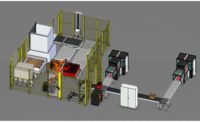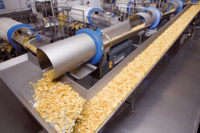In the baking industry, manufacturers routinely use conveyors throughout their facilities to move products along the line to get them processed, packaged, and out to customers. Beyond the basics, how can value-added conveyors save manufacturers time and money, producing more significant ROI? Let’s look at how they can streamline the processing line.
How value-added conveyors can help baked goods manufacturers
In a baked goods manufacturing facility, conveyors are used to move product around as it proceeds through the various steps of preparation. What’s not always considered is that conveying equipment can be enhanced to help complete steps while the product is in motion. This allows facilities to perform more efficiently.
To understand how this might be incorporated, think about how a product might be manipulated while moving along on a conveyor. For example, a manufacturer might need to add nuts or cover an item in chocolate.
What types of actions can a value-added conveyor do?
There’s a conveyor adaptation to fit almost any action that might be needed to prepare the product for the next stage of the process.
Conveyors can be designed to manipulate the product so it can be ready for the next step in production. This may include completing actions used when producing baked goods, such as:
- Flipping or turning
- Merging
- Sorting
- Sizing
- Aligning
- Compressing
- Sprinkling an ingredient on top
- Stuffing ingredients inside
- Enrobing/waterfall
- Cutting or chunking
Advantages of value-added conveyance solutions
What can value-added conveyance solutions mean for a company that produces baked goods? There are numerous advantages:
- Money saved: When time and labor are saved, cost savings also result. The cost of an optimized conveyor is usually less than a separate machine, meaning it's more likely to stay within a manufacturer’s budget.
- Addressing a worker shortage: Some positions in manufacturing facilities can be hard to fill because the jobs can be repetitive and may be tedious. Turnover is often high. Using value-added conveying solutions helps address this challenge by automating such tasks on the line.
- Increased project efficiency: By relying on the conveyor OEMs to figure out the manipulation, it can save time for the manufacturer’s engineering team. In addition, working with fewer suppliers saves project management time. Using less equipment is easier and more streamlined for operations, sanitation, and maintenance.
- Improved food safety: Using a machine versus a human worker to complete some steps of the manufacturing process reduces the potential for products to be contaminated.
- Better precision: Conveying equipment aligns the ingredients and portions used in baking more precisely than a human can.
- Reduced waste: Less waste is produced when conveyors are designed to take care of processes like sprinkling nuts on a product. The conveyor can be designed to catch the nuts that fall off, which can then be cycled back into the process instead of discarded.
- Smaller footprint: Value-added conveying equipment also saves floor space, which impacts the logistics of a baking facility.
Guidelines for choosing a value-added conveyor supplier
For manufacturers of baked goods who are considering value-added conveyance solutions, follow these guidelines:
- Get a conveying equipment partner involved early: Choose a supplier to rely on, then get them involved before making crucial decisions about how to process a bakery item. The earlier they can get involved, the more efficiency they can bring to processes.
- Ask for an assessment of the production process and facility: Once a partner is chosen, they can perform an assessment of the production facility. They can then provide recommendations on specific pieces of equipment that can be incorporated based on a baker’s unique needs. The sooner this is done, the more helpful it may be. It makes processes more efficient, resulting in a smaller footprint.
- Consider conveyance technology during process development: To build even more efficiency into processes, factor conveyance into the process development stage. For example, in-house engineering teams may not think about how a conveyor can add value during the production of baked goods. By working with a partner in the conveyor space, manufacturers can gain insight that may be helpful in designing their processes.
- Choose a supplier who understands the baking industry applications: When considering a supplier to work with, be sure to choose one with baking industry experience. A partner that knows food processing applications inside and out saves time searching for engineering resources that may be difficult to find. They can easily build on existing solutions or tweak projects as needed to perfect them to fit a new application.
- Think about supporting equipment: Once the right conveyance equipment is in place, consider supporting equipment to create complete conveyance and bulk handling systems. This may include dumpers, platforms, lifts, sanitary parts carts, and elevators.
- Add installation and maintenance services: Some conveyance equipment manufacturers also offer installation and maintenance services. Partnering with the conveyance OEM to install and service equipment streamlines the project by leveraging experts that understand how to integrate it into the line efficiently and accurately.
As baked goods manufacturers develop new products and perfect existing processes, value-added conveyors help them work smarter by enhancing their line while saving on the bottom line.



